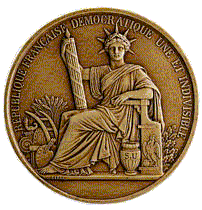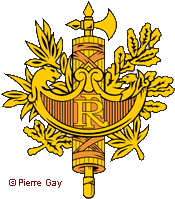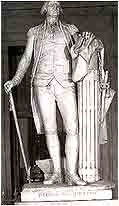
![]()

![]()

![]() Fasces
symbolise summary power and jurisdiction. The word is the
plural of the Latin word fascis, meaning bundle. Traditional
Roman fasces were bundles of birch rods tied together with
a red ribbon to form a cylinder around an axe. Many western
governments have used fasces as symbols of power.
Fasces
symbolise summary power and jurisdiction. The word is the
plural of the Latin word fascis, meaning bundle. Traditional
Roman fasces were bundles of birch rods tied together with
a red ribbon to form a cylinder around an axe. Many western
governments have used fasces as symbols of power.
Italian Fascists took their name from the Fascis, but the symbolism is much greater and fasces have avoided much of the stigma associated with twentieth century fascism.
Roman fasces looked like the ones on the far left, with the axe head sticking out from the bundle, but most modern representations show the act, sometimes double headed, projecting from the top of the bundle, as shown on the right. The picture on the far left is a photograph of a roman tomb. The one next to it is a modern reproduction - less neatly bound it has to be said.


![]()
![]()
![]()
![]() The
fasces lictoriae ("bundles of the Lictors") symbolised
the imperium (power and authority) of ancient Rome. Lictors
formed a corps of apparitores, subordinate officials
who each carried fasces as a symbol of office before a magistrate
during Roman public ceremonies - rather like modern mace
bearers who precede Lord Chancellors, Judges, Mayors and
University Chancellors. Bearers of fasces preceded other
officials including consuls and proconsuls. In Rome, heroic
soldiers carried fasces in triumphal processions. The symbolism
of the fasces was already ancient even in Roman times. Roman
historians recorded that twelve Lictors had accompanied
the Etruscan kings of Rome in the distant past.
The
fasces lictoriae ("bundles of the Lictors") symbolised
the imperium (power and authority) of ancient Rome. Lictors
formed a corps of apparitores, subordinate officials
who each carried fasces as a symbol of office before a magistrate
during Roman public ceremonies - rather like modern mace
bearers who precede Lord Chancellors, Judges, Mayors and
University Chancellors. Bearers of fasces preceded other
officials including consuls and proconsuls. In Rome, heroic
soldiers carried fasces in triumphal processions. The symbolism
of the fasces was already ancient even in Roman times. Roman
historians recorded that twelve Lictors had accompanied
the Etruscan kings of Rome in the distant past.

![]() Fasces
suggest strength through unity. A bundle of rods bound together
possesses more strength than its consistuent rods. The rods
themselves symbolised the state's power to punish delinquents
- beatings were carried out using birch rods, sometimes
rods taken from a fascis. The axe represented the ultimate
power to execute people, by decapitating them. It has a
long history in eastern Mediterranean countries. Fasces
carried within the limits of the sacred inner City of Rome
generally had their axe blades removed. This signified that
the imperium-bearing magistrates did not have the judicial
power of life and death. That power rested, within the City,
with the people through their assemblies. However, during
emergencies, when the Roman Empire was placed under a dictatorship
(dictatura), Lictors attending to the Dictator retained
their axe blades even inside the inner City — a sign
that the Dictator possessed the ultimate power.
Fasces
suggest strength through unity. A bundle of rods bound together
possesses more strength than its consistuent rods. The rods
themselves symbolised the state's power to punish delinquents
- beatings were carried out using birch rods, sometimes
rods taken from a fascis. The axe represented the ultimate
power to execute people, by decapitating them. It has a
long history in eastern Mediterranean countries. Fasces
carried within the limits of the sacred inner City of Rome
generally had their axe blades removed. This signified that
the imperium-bearing magistrates did not have the judicial
power of life and death. That power rested, within the City,
with the people through their assemblies. However, during
emergencies, when the Roman Empire was placed under a dictatorship
(dictatura), Lictors attending to the Dictator retained
their axe blades even inside the inner City — a sign
that the Dictator possessed the ultimate power.
The Fasces In France. Once the monarchy had been abolished the new French Republic needed new symbols the represent the state and its power to replace the old royal symbols such as the fleur-de-lis and the royal crown.

![]()

![]() Liberty
and later Marianne
provided symbols for the revolutionary state while fasces
provided an ideal symbol to represent the authority of the
State. It is often hidden away in the background.
Liberty
and later Marianne
provided symbols for the revolutionary state while fasces
provided an ideal symbol to represent the authority of the
State. It is often hidden away in the background.
In the depiction on the left it accompanies two French tricolore flags and the national cypher RF. It is just visible behind the wreath.
In the depiction on the right it is less well hidden, this time by a poster with the new national motto. The axe head is completely concealed by a Phrygian cap (or Cap of Liberty).

![]()


![]() It
also features prominently on the French
Seal of State, but here the axe has been lost completely
and replaced by a spear. Fasces also appear on the (still
unofficial) French
Coat of Arms - still in the background but much more
prominent, and with no attempt to hide the axe head. Similarly
on the representation in blue to the right where it is scarcely
concealed at all by the Motto
of the Republic.
It
also features prominently on the French
Seal of State, but here the axe has been lost completely
and replaced by a spear. Fasces also appear on the (still
unofficial) French
Coat of Arms - still in the background but much more
prominent, and with no attempt to hide the axe head. Similarly
on the representation in blue to the right where it is scarcely
concealed at all by the Motto
of the Republic.
 |
 |
 |
 |
The fasces is one of the gererally recognised symbols of sovereignty not mentioned in article 2 of the French Constitution of 1958, which refers only to le drapeau tricolore, bleu, blanc, rouge: The French Flag , L'hymne national, the national anthem, The Marseillaise and La devise de la République; the motto . "Liberté, Égalité, Fraternité".
The Fasces Used in the USA and Elsewhere
 As
well as the French examples given above, fasces are used
today throughout the west, for example by the Spanish Guardia
Civil (paramilitary police) and by the Norwegian and the
Swedish police.
As
well as the French examples given above, fasces are used
today throughout the west, for example by the Spanish Guardia
Civil (paramilitary police) and by the Norwegian and the
Swedish police.
![]()
![]()

![]()

![]() The
symbol also widely used in the USA. The official seal of
the United States Senate features a pair of crossed fasces
(seal on the right, detail on the left).
The
symbol also widely used in the USA. The official seal of
the United States Senate features a pair of crossed fasces
(seal on the right, detail on the left).

 At
the Lincoln Memorial in Washington, Lincoln's seat of state
bears the fasces on the fronts of its arms.
At
the Lincoln Memorial in Washington, Lincoln's seat of state
bears the fasces on the fronts of its arms.
 Crossed
fasces also appear on the badge of the US National Guard.
Crossed
fasces also appear on the badge of the US National Guard.
A frieze on the facade of the Supreme Court building depicts the figure of a Roman Centurion holding a fasces
|
|
 |

![]()

![]()

![]() The
reverse of the United States "Mercury" dime (see
right) bears the design of a fasces (a proper Roman style
one) and an olive branch.
The
reverse of the United States "Mercury" dime (see
right) bears the design of a fasces (a proper Roman style
one) and an olive branch.
A statue of Washington (see left) shows him leaning on a fasces, though the top of it, including the axe head is discreetly covered.
The symbol on the far right is a design from an envelope used during the American Civil War which also features a Phrygian cap (or Cap of Liberty) on a liberty pole.





